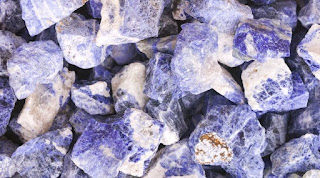When we were children, maybe we often played colorful sand. Well, in nature there are actually many natural variations of color sand. Some colors are even rare and only exist in a few countries.
For example, there are black sand beaches in Iceland that are a tourist draw, and jewel-like beaches in Alaska filled with beautiful minerals. In Namibia, you can find bright blue sand.
Blue is a rare color in nature. Less than 10% of the world's flowering species are capable of producing this color. In rocks, it can occur as a mineral called sodalite. This rock-forming mineral is found in igneous rocks that crystallize in sodium-rich magmas.
Quoted from IFL Science, sodalite contains sodium, aluminum, silicon, oxygen, and chlorine and can be uniform in color or streaked so that it looks like a stormy seascape on rock.
These minerals form rocks. But in areas where sodalite commonly forms, larger deposits may be the result of human activity as sodalite mining grinds the minerals down to sand-like sizes. Sodalite is found all over the world, including the US, Canada, Russia and Greenland, but perhaps the most special is in Namibia.
Understanding where natural sand comes from can explain why it appears different colors in different areas. Erosion from wind and waves is a natural blessing of sand as they can crush larger rocks down to the seafloor as tiny specks which are often seen when we visit the beach.
As a result, natural sand has almost any color of rock present in a given area. In Namibia, a combination of mining and erosion creates sodalite sand among natural samples, but until recently there had never been enough sodalite in one place to create an all blue beach.
The odd but beautiful Alaskan sand also contains some bluish specimens, but this is the result of glauconite, the ferrous potassium phyllosilicate mineral. Here, the minerals olivine and iron oxide also give rise to green and orange sand, respectively.
The strangest colorful beaches can perhaps be found in California. There, Fort Bragg shards of glass and pulverized pottery created enough man-made pebbles to coat the entire coastline. These unusual boulders are the result of the beach's historic use as a garbage dump from 1943 to 1967.
So, next time you're at the beach, grab a handful of sand and see what color of sand you find. Who knows, you will become the discoverer of uniquely colored sand.


